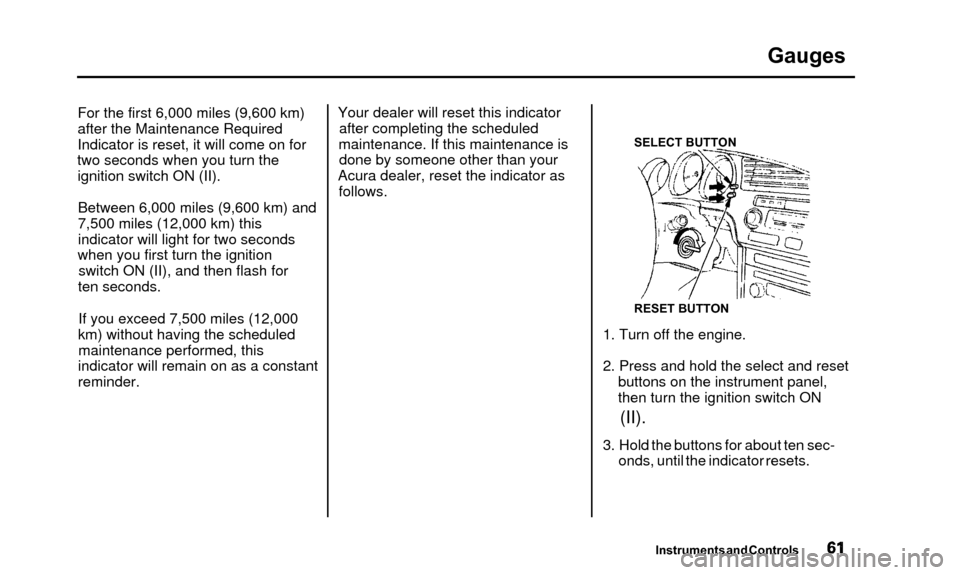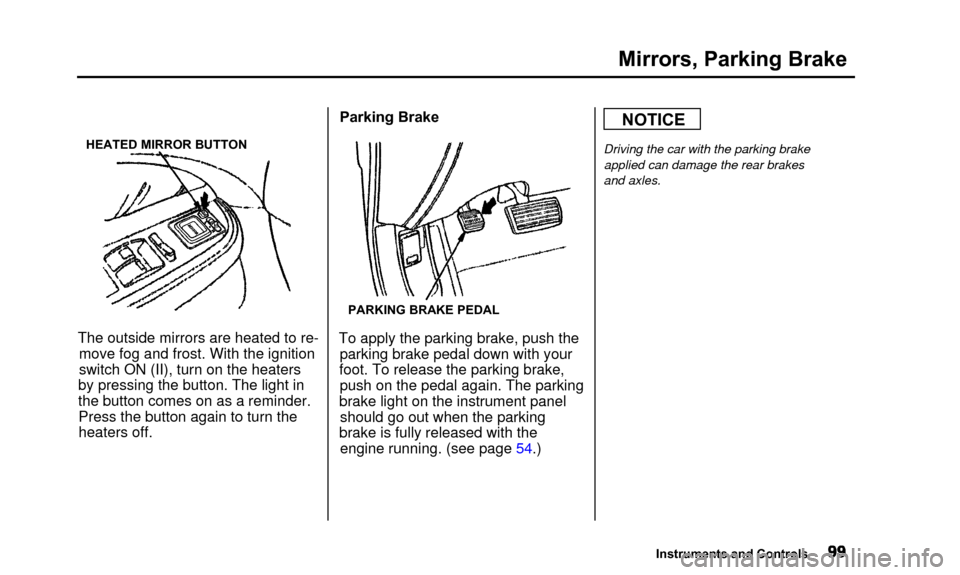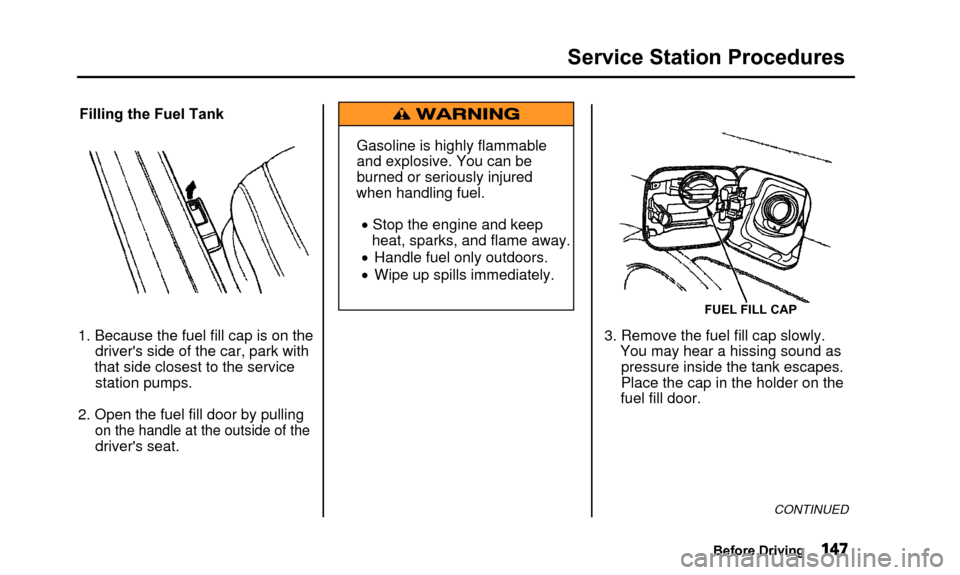engine Acura TL 2000 3.2 User Guide
[x] Cancel search | Manufacturer: ACURA, Model Year: 2000, Model line: TL, Model: Acura TL 2000Pages: 311, PDF Size: 3.05 MB
Page 64 of 311

Gauges
For the first 6,000 miles (9,600 km)
after the Maintenance Required
Indicator is reset, it will come on for
two seconds when you turn the ignition switch ON (II).
Between 6,000 miles (9,600 km) and
7,500 miles (12,000 km) this
indicator will light for two seconds
when you first turn the ignition switch ON (II), and then flash for
ten seconds.
If you exceed 7,500 miles (12,000
km) without having the scheduled maintenance performed, this
indicator will remain on as a constant
reminder. Your dealer will reset this indicator
after completing the scheduled
maintenance. If this maintenance is done by someone other than your
Acura dealer, reset the indicator as follows.
SELECT BUTTON
RESET BUTTON
1. Turn off the engine.
2. Press and hold the select and reset buttons on the instrument panel,
then turn the ignition switch ON
(II).
3. Hold the buttons for about ten sec- onds, until the indicator resets.
Instruments and Controls
Page 76 of 311

Keys and Locks
Keys
KEY MASTER
NUMBER KEY
PLATE (BLACK) VALET KEY
(GREY)
Your car comes with two master
keys and a valet key.
The master key fits all the locks on your car: • Ignition
• Doors• Glove box
• Trunk pass-through cover The valet key works only in the
ignition and the door locks. You can
keep the trunk, trunk pass-throughcover, and glove box locked when
you leave your car and the valet key at a parking facility.
You should have received a key number plate with your set of keys.
You will need this number if you have to get a lost key replaced. Keepthe plate stored in a safe place.
When replacing keys, use only
Acura-approved key blanks.
These keys contain electronic circuits that are activated by theImmobilizer System. They will not
work to start the engine if the circuits are damaged.
• Protect the keys from direct sunlight, high temperature, and
high humidity.
• Do not drop the keys or set heavy objects on them.
• Keep the keys away from liquids.If they get wet, dry them immedi-
ately with a soft cloth.
The keys do not contain batteries. Do not try to take them apart.
Remote Transmitter
Your car also comes with two remote transmitters; see page 78 for anexplanation of the operation.
Instruments and Controls
Page 77 of 311

Keys and Locks
Immobilizer System
The Immobilizer System protects your car from theft. A properly-coded master or valet key must be
used in the ignition switch for theengine to start. If an improperly-
coded key (or other device) is used,
the engine's starting circuit is disabled.
When you turn the ignition switch to ON (II), the Immobilizer System
indicator should come on for a few seconds, then go out. If the indicator
starts to blink, it means the system
does not recognize the coding of the
key. Turn the ignition switch to LOCK (0), remove the key, reinsert
it, and turn the switch to ON (II) again. The system may not recognize your
key's coding if another immobilizer
key or other metal object is near the ignition switch when you insert the
key. To make sure the system recognizes the key code:
• Do not keep other immobilizer keys on the same key ring.
• Use a plastic or leather key fob, not metal.
• Keep other keys away from yourcar's key and the ignition switch
while trying to start the engine.
If the system repeatedly does not
recognize the coding of your key,
contact your Acura dealer. This indicator will also blink several
times when you turn the ignitionswitch from ON (ID to ACCESSORY (I) or LOCK (0).
Do not attempt to alter this system or add other devices to it. Electrical
problems could result that may make
your car undriveable.
If you have lost your key and you
cannot start the engine, contact your
Acura dealer.
Instruments and Controls
Page 79 of 311

Keys and Locks
ACCESSORY (I) - In this position,you can operate the audio systemand the accessory power socket.
ON (II) — This is the normal key
position when driving. All features
and accessories on the car are usable.
Several of the lights on the instru-
ment panel come on as a test when
you turn the ignition switch from
ACCESSORY to ON. START (III) - Use this position
only to start the engine. The switch
returns to ON (II) when you let go of
the key.
The engine will not start if the
Immobilizer System does not
recognize the key's coding (see page
74).
You will hear a reminder beeper if
you leave the key in the ignition
switch in the LOCK (0) or
ACCESSORY (I) position and open the driver's door. Remove the key to
turn off the beeper.
Instruments and Controls
Page 97 of 311

Seat Heaters
Both front seats are equipped withseat heaters. The ignition switch
must be ON (II) to use them. Push
the front of the switch, HI, to rapidly
heat up the seat. After the seat
reaches a comfortable temperature, select LO by pushing the back of the
switch. This will keep the seat warm. The HI or LO indicator lights and
remains lit until you turn it off by
pushing the opposite side of theswitch lightly. The indicator will turn
off.
In HI, the heater turns off when the
seat gets warm, and turns back on
after the seat's temperature drops. It
continues to cycle as long as you
leave it set on HI. The HI indicator
remains lit as a reminder that you
have the heater on.
In LO, the heater runs continuously.
It does not cycle with temperaturechanges. Follow these precautions whenever
you use the seat heaters:
• Use the HI setting only to heat the seats quickly. Select the LO
setting when the seats feel warm.
The HI setting draws large amounts of current from the
battery.
• Do not use the seat heaters, even on the LO setting, if the engine is
left idling for an extended period.
They can weaken the battery, causing hard starting.
Because of the sensors for the side
airbag system, there is no heater in
the passenger's seat-back.
Instruments and Controls
Page 102 of 311

Mirrors, Parking Brake
HEATED MIRROR BUTTON
The outside mirrors are heated to re-move fog and frost. With the ignition
switch ON (II), turn on the heaters
by pressing the button. The light in
the button comes on as a reminder. Press the button again to turn theheaters off. Parking Brake
PARKING BRAKE PEDAL
To apply the parking brake, push the
parking brake pedal down with your
foot. To release the parking brake, push on the pedal again. The parking
brake light on the instrument panel should go out when the parking
brake is fully released with the engine running. (see page 54.)
NOTICE
Driving the car with the parking brake
applied can damage the rear brakes
and axles.
Instruments and Controls
Page 113 of 311

Climate Control System
The automatic climate controlsystem in your Acura picks the
proper combination of air condi-
tioning, heating, and ventilation to maintain the interior temperature
you select. The system also adjusts the fan speed and air flow levels.
The direction of air flow from the vents in the center and each side ofthe dashboard, and in back of thecenter console is adjustable.
To adjust the air flow from each vent, move the tab in the center of each
vent up-and-down and side-to-side.
The side and rear vents can be opened and closed with the dials.CENTER VENTS
The climate control system draws airthrough the exterior vents at the
bottom of the windshield. Keep
these vents clear of leaves and otherdebris.
DRIVER'S-SIDE VENT
For the climate control system to
provide heating and cooling, the
engine must be running.
Comfort and Convenience Features
Page 148 of 311

Before Driving
Before you begin driving your Acura,
you should know what gasoline to
use, and how to check the levels of important fluids. You also need to
know how to properly store luggage or packages. The information in this
section will help you. If you plan to
add any accessories to your car,
please read the information in this section first. Break-in Period
..................... 146
Gasoline.............................. 146
Service Station Procedures.......... 147
Filling the Fuel Tank ................ 147
Opening the Hood.................. 148
Oil Check............................
150
Engine Coolant Check ......... 151
Fuel Economy...........................
152
Vehicle Condition.................... 152
Driving Habits.......................... 152
Accessories and Modifications..... 153
Carrying Cargo........................... 155
Before Driving
Page 149 of 311

Break-in Period, Gasoline
Break-in Period
Help assure your car's future
reliability and performance by payingextra attention to how you drive
during the first 600 miles (1,000 km).
During this period:
• Avoid full-throttle starts and rapid acceleration.
• Avoid hard braking. New brakesneed to be broken-in by moderate
use for the first 200 miles (300
km).
You should follow these same re- commendations with an overhauledor exchanged engine, or when the
brakes are relined. Gasoline
Your Acura is designed to operate on
premium unleaded gasoline with a
pump octane number of 91 or higher.
Use of a lower octane gasoline can cause occasional, metallic knocking
noises in the engine and will result
in decreased engine performance.
We recommend gasolines containing detergent additives that help prevent
fuel system and engine deposits. Using gasoline containing lead will
damage your car's emissions
controls. This contributes to air
pollution. In Canada, some gasolines contain
an octane-enhancing additive called
MMT. If you use such gasolines,
your emissions control system performance may deteriorate and
the Malfunction Indicator Lamp on
your instrument panel may turn on. If this happens, contact your
authorized Acura dealer for service.
Before Driving
Page 150 of 311

Service Station Procedures
Filling the Fuel Tank
1. Because the fuel fill cap is on the driver's side of the car, park with
that side closest to the service station pumps.
2. Open the fuel fill door by pulling
on the handle at the outside of the
driver's seat. Gasoline is highly flammable
and explosive. You can be
burned or seriously injured
when handling fuel.
• Stop the engine and keep heat, sparks, and flame away.
• Handle fuel only outdoors.
• Wipe up spills immediately.
FUEL FILL CAP
3. Remove the fuel fill cap slowly. You may hear a hissing sound aspressure inside the tank escapes.
Place the cap in the holder on the
fuel fill door.
CONTINUED
Before Driving